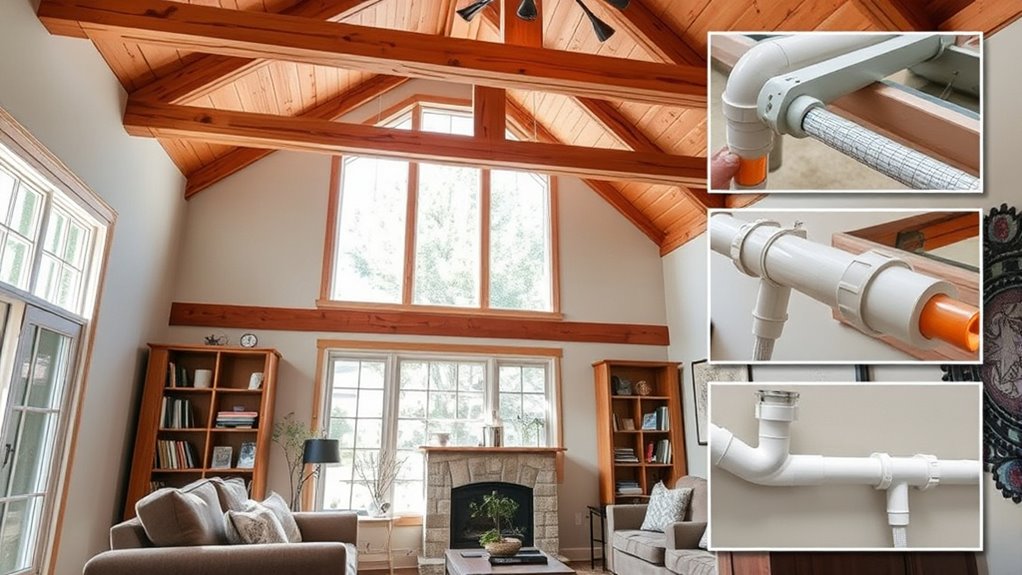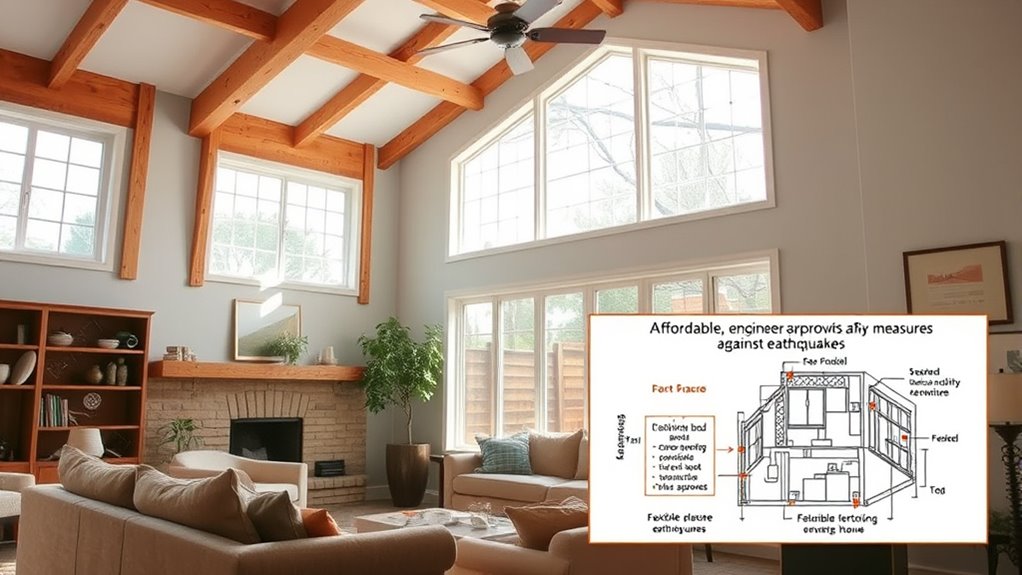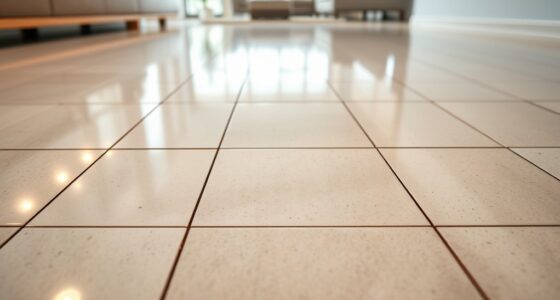To earthquake-proof your home on a budget, focus on seismic retrofitting and securing household items. Reinforce vulnerable parts like your foundation, walls, and roof with simple measures, and anchor heavy furniture and appliances with brackets and straps. Installing shatterproof films on windows and checking for cracks helps prevent damage. Regular inspections and quick maintenance boost safety. If you’re interested in low-cost tips to protect your home and loved ones, there’s more you should consider.
Key Takeaways
- Reinforce key structural elements like the foundation, walls, and roof to enhance earthquake resistance cost-effectively.
- Secure heavy furniture and appliances with brackets and straps to prevent movement during tremors.
- Install shatterproof window film or locks to minimize glass hazards without expensive window replacements.
- Conduct regular home inspections to identify and repair cracks or weaknesses early, maintaining overall stability.
- Develop an emergency plan and assemble supplies to ensure safety and preparedness without significant expense.

Living in an earthquake-prone area doesn’t mean you have to spend a fortune to protect your home. You can implement effective safety measures without breaking the bank. One of the most impactful steps is seismic retrofitting, which strengthens your home’s structure to better withstand seismic forces. This process involves reinforcing vulnerable parts of your house—such as the foundation, walls, and roof—so that it remains stable during a quake. Many homeowners overlook this, but investing in seismic retrofitting offers peace of mind and markedly reduces damage and injury risk. You don’t need to overhaul your entire home; even targeted retrofitting of key structural elements can make a substantial difference.
Seismic retrofitting strengthens your home’s structure to withstand earthquakes and reduce damage.
Beyond seismic retrofitting, there are numerous affordable safety measures you can take to make your home more resilient. Securing heavy furniture, appliances, and shelves prevents dangerous movements during shaking. Use brackets, straps, and anchors to fasten these items to walls, which minimizes the risk of falling objects that could cause injury. Installing simple safety latches on cabinets keeps dangerous items inside from spilling out during tremors. Another cost-effective step is upgrading your windows with shatterproof film or installing window locks to prevent glass from breaking and flying around. These small investments can save you money on repairs and hospital bills.
Additionally, you should examine your home’s foundation and look for cracks or weaknesses. Filling small cracks and ensuring proper drainage around your property helps maintain stability over time. It’s also wise to check the roofing and connections to your walls, reinforcing where necessary to prevent collapse or damage. Regular home inspections can identify potential issues early, saving you money and stress in the long run. Many of these improvements are straightforward and can be completed with basic tools and materials, making them accessible even if you’re on a tight budget. Incorporating seismic-resistant features into your planning can further enhance your home’s ability to withstand earthquakes.
Planning ahead is vital, so create an emergency kit and develop a family plan for what to do during and after an earthquake. These preparations are inexpensive but can save lives. Keep your supplies—water, food, first aid, and essentials—organized and accessible. Practice drills with your family so everyone knows how to drop, cover, and hold on quickly. Understanding earthquake preparedness techniques can significantly reduce panic and injury during an actual event.
Frequently Asked Questions
Can Everyday Household Items Help Reinforce My Home Against Earthquakes?
You can use everyday household items to reinforce your home against earthquakes. For example, furniture anchoring keeps heavy pieces from tipping over, reducing injury risk. Reinforcing windows with tape or plywood can prevent shattered glass during tremors. These simple steps, like securing furniture and adding window reinforcement, are affordable and effective ways to make your home safer without spending much, giving you peace of mind during seismic activity.
Are There Specific Areas of My Home That Are More Vulnerable to Quake Damage?
You should focus on foundation vulnerabilities and window fragility, as these are common weak spots during earthquakes. Your home’s foundation can crack or shift, so reinforce it with steel or concrete where possible. Windows are prone to shattering, so adding shatter-resistant film or braces helps. These areas are more vulnerable, so prioritizing their reinforcement reduces damage and keeps your home safer during seismic events.
How Often Should I Inspect and Maintain Earthquake Safety Measures?
Think of your home as a ship sailing through rough seas; regular check-ups keep it seaworthy. You should conduct a seismic risk assessment and safety inspection schedule at least once a year. After significant weather events or earthquakes, inspect your safety measures promptly. Staying vigilant guarantees your home remains resilient, giving you peace of mind knowing you’re prepared for any tremors that come your way.
Do Insurance Policies Typically Cover Earthquake Damage Repairs?
You might wonder if your insurance policy covers earthquake damage. Typically, standard home insurance doesn’t include earthquake coverage, so you’ll need a separate policy or endorsement. Be aware of policy exclusions—some policies limit or exclude earthquake repairs. To avoid surprises, review your coverage carefully and ask your insurer about specific earthquake-related exclusions. This way, you’re better prepared and know what to expect if an earthquake causes damage.
Can DIY Methods Effectively Earthquake-Proof My Home Without Professional Help?
You might wonder if DIY upgrades can effectively earthquake-proof your home. While some cost-effective enhancements, like securing heavy furniture and adding braces, help improve safety, they don’t replace professional assessments. DIY methods can strengthen certain areas, but for thorough earthquake protection, consulting experts ensures your home is properly reinforced. Relying solely on DIY may leave gaps, so balance cost-effective enhancements with professional advice for the best safety results.
Conclusion
So, while you’ve spent time bolstering your home against quakes, remember that no amount of prep can guarantee safety. Ironically, the very effort to protect your home might make you feel more secure—until nature reminds you who’s really in charge. Still, taking these affordable steps gives you peace of mind, even if it’s just a comforting illusion. After all, sometimes the best earthquake-proofing is knowing you did your best—and hoping that’s enough.
Amina brings over a decade of journalism experience to her role as Editor-in-Chief. Under her leadership, Exquisite Post has flourished, maintaining the highest standards of integrity and excellence. Amina’s commitment to truth and her visionary approach guide the editorial team in producing impactful news stories that resonate with our audience.










